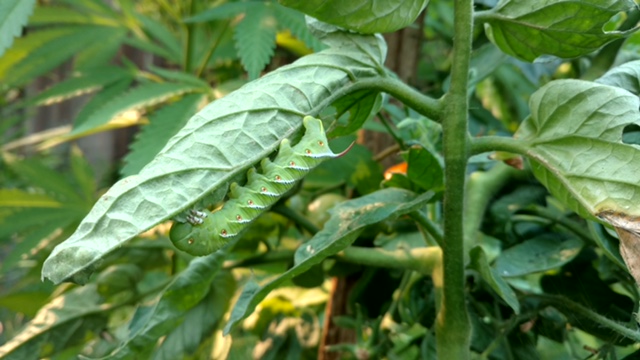Attack of the tomato hornworms!

The tomato hornworm's coloring makes it hard to see among tomato leaves. Look for its poop on leaves below or, at night, search using a UV flashlight. (Photo: Debbie Arrington)
August heat brings out spike in population of these giant caterpillars

By Debbie Arrington
They look like something out of a sci-fi movie – if you can spot them. And what they do to tomato plants is absolutely horrifying.
Recent hot, dry weather brought out a late-summer surge of one of the biggest bugs in our vegetable gardens: The tomato hornworm.
They love these last days of summer – and munching away on ripe tomatoes. While many critters retreat in high heat, these invaders actually spike in numbers and activity as the mercury rises.
Natural enemies usually keep their populations under control. But hornworm numbers tend to go up in August along with the temperature.
I saw this firsthand in my own Sacramento garden. I've picked off five hornworms from my tomato vines in five days.
Fat as a finger and just as long, hornworms rank as Sacramento’s largest caterpillars. They eat big bites out of their favorite food: Juicy tomatoes. They’ll also eat hard green tomatoes, leaves and stems.
Their stripes let them hide in plain sight. They blend in so well with their surroundings, they can seem impossible to spot.
What’s easy to see are leaves that have been stripped bare to the stem and damaged tomatoes. Other pests and critters may take bites out of tomatoes, but those stripped leaves – especially if the damage seems to appear overnight – usually indicate hornworms.
If you suspect hornworms, look for their poop. They leave large black or green droppings on or around the plant. If you see those droppings, carefully inspect the plant’s nearby leaves and stems. When you find it, pick off the hornworm and dispose of it. (Folks who raise chickens say their hens love them as a snack.)
If the hornworm escapes capture, it burrows into the soil and pupates into a moth of equally gigantic proportion: The hawk moth. Emerging in spring, this brown and gray moth has a 5-inch wingspan.
Rototilling the tomato bed after harvest prevents those moths from ever developing – and laying eggs next spring.
For more on tomato hornworms: http://ipm.ucanr.edu/PMG/GARDEN/VEGES/PESTS/hornworm.html


Comments
Post a Comment